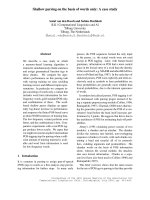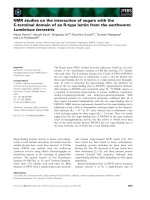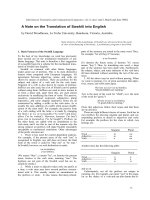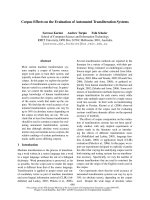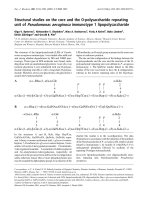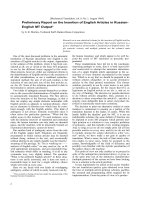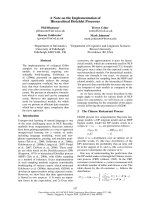Báo cáo y học: "Safety concerns on the development of novel therapeutic drugs" docx
Bạn đang xem bản rút gọn của tài liệu. Xem và tải ngay bản đầy đủ của tài liệu tại đây (38.39 KB, 3 trang )
Page 1 of 3
(page number not for citation purposes)
Available online />Abstract
Along with recent innovative approaches resulting in the
development of new therapies such as small molecular inhibitors,
therapeutic antibodies, recombinant proteins and gene therapy,
there is increasing need for improved understanding of the basic
molecular mechanisms that are exploited by such treatments.
Helpful tools in the analysis of drug effects include high-throughput
screening techniques such as microarrays, which are used in
transcriptomics and pharmacogenomics. Although we are far from
using these extensive and costly tests in our daily clinical routine,
their application in basic research nevertheless takes us closer to
individualized therapeutic strategies, in which the optimal
therapeutic regimen is identified for each individual patient.
With the current trend toward development of specific,
molecular targeted therapies, the translation of basic science
research to clinical medicine is more important than ever.
However, it is similarly important to take a step back from the
bedside to the bench. In the development process, new
therapeutic substances are extensively tested in vitro and in
animal and clinical studies. These tests thoroughly describe
the pharmacological and toxicological properties of the drug,
but they often fail to grasp the complex effects of a drug on
its target cells. In many cases, unexpected negative but also
positive effects of a substance are only revealed after longer
term clinical use. In this commentary we highlight some
possible approaches to analyzing the properties of a
substance at the cellular level and to deriving a more complete
picture of the impact of a treatment on the human body.
A prime example for bringing basic research results into
clinical use lies in the development of anti-tumour necrosis
factor (TNF) therapies for patients with rheumatoid arthritis.
The anti-TNF approach not only introduced another effective
treatment option for rheumatoid arthritis patients but it also
gave new insights into the pathological mechanism of the
disease. However, the mechanisms of action of anti-TNF
agents are still not fully understood, and some of the adverse
effects cannot readily be explained. Furthermore, it is not clear
why about 30% of patients respond insufficiently to anti-TNF
treatment [1]. In light of the costs of biological therapies and
their potential side effects, a reliable strategy for identifying
nonresponders as soon as possible – ideally even before
initiation of therapy – would be of great importance.
In recent years gene expression profiling with microarray
technology emerged as a powerful tool with which to
elucidate biological pathways in health and disease. It offers
the possibility to study simultaneously the expression of
thousands of genes and to observe changes in gene
expression during pathological states or pharmacological
interventions. In order to gain valid information from array
experiments, it is crucial first to process accurately the vast
amount of raw data generated, but then also to translate
purely descriptive array data into information on potentially
important and functional biological mechanisms [2]. A
number of research groups have analyzed gene expression
profiles of patients with rheumatic diseases in order to
elucidate pathological mechanism and define potential new
drug targets (for review [3]). The same strategy can be used
to find differences in gene expression profiles between
responders and nonresponders. In juvenile arthritis it could be
shown that 2-4 weeks after the onset of treatment the gene
expression profile of patients benefiting from the therapy
changed toward the profile of healthy control individuals,
whereas the profile of patients who turned out to be
nonresponders did not [4]. Thus, observation of changes in
the transcriptome could help in monitoring the influence of a
drug on disease progression and to find the best therapeutic
regimen for each individual patient. However, before gene
expression arrays can be used to predict response to therapy
in clinical practice, their application must become much
quicker, cheaper and more user friendly. AlloMap™ (XDx, San
Francisco, CA, USA) is an example of a system for monitoring
changes in gene expression that may be applied clinically. By
measuring the expression levels of 11 different genes
associated with immune system pathways in peripheral blood
Commentary
Safety concerns on the development of novel therapeutic drugs
Caroline Ospelt and Steffen Gay
Center of Experimental Rheumatology, Zürich, Switzerland
Corresponding author: Caroline Ospelt,
Published: 1 September 2006 Arthritis Research & Therapy 2006, 8:112 (doi:10.1186/ar2032)
This article is online at />© 2006 BioMed Central Ltd
TNF = tumour necrosis factor.
Page 2 of 3
(page number not for citation purposes)
Arthritis Research & Therapy Vol 8 No 5 Ospelt and Gay
cells, this assay helps to identify those patients who are at
high risk for acute allograft rejection following heart
transplantation [5].
Although gene expression studies with whole blood samples
or tissues often are biased by variations in cellular
composition, in vivo analysis of homogenous cell populations
under stable conditions facilitates the detection of pathways
that are affected by the treatment. In this way, new
information about the mechanisms of action and off-target
effects of a drug can be gained. An understanding of the
molecular mechanisms that are triggered by a substance
possibly may widen its field of indication or promote the
development of more specific compounds. Another advan-
tage of testing sorted cell populations is the ability to
determine the contribution of a single cell type to the overall
effect. Thereby, new information about pathophysiological
mechanisms can be gained and differences in the activation
of human and animal cells detected. This is of special interest
for novel therapeutic strategies that are specifically designed
for the human environment, such as small molecular
inhibitors, but also for agonistic antibodies, recombinant
proteins and gene therapy approaches. In this setting, results
from animal studies can be misleading because the treatment
response in animals can differ considerably from that in
humans. A recent example of such a mismatch is the
application of a CD28 agonistic antibody. Although tests in
animals showed a selective activation of regulatory T cells,
application in humans led to a life-threatening immune
reaction [6]. Whether this potent adverse effect was due to a
cytokine storm triggered by activated helper T cells, as
suggested by the developer, or was due to some other
mechanisms is not yet clear.
In order to mimic the response of the human immune system
to a therapeutic antibody, ‘humanized’ animal models such as
immunodeficient mice reconstituted with a human immune
system could be applied in the future. Recently developed
humanized mouse models have considerable levels of
engraftment and the achieved reconstitution is almost
absolute. However, the degree to which the different parts of
the immune system are functional has not yet been
determined [7]. Therefore, it remains to be clarified whether
such models can actually be used to improve the safety of
testing immunomodulatory pharmaceuticals in humans.
A novel approach to finding the optimal treatment for each
individual patient is pharmacogenomics, in which genetic
polymorphisms in drug-metabolizing enzymes, drug
transporters, or drug targets are studied and linked to the
patient’s response to a drug. A number of studies have been
conducted in rheumatoid arthritis patients with the aim of
predicting response to therapy on the basis of genetic
variations. Polymorphisms in methotrexate transporter genes
and in several other key genes in the methotrexate pathway
have been reported to be associated with the efficacy and
toxicity of the drug [8]. Similarly, it was shown that
polymorphisms in the TNF promoter and/or the TNF receptor
II probably influence response to anti-TNF treatment, as did
genetic variations in the interleukin-10 promoter and the Fcγ
receptor IIIA [9-12]. However, the results of the various
pharmacogenomic studies in rheumatoid arthritis are not
sufficiently conclusive to justify the introduction of this
technology into clinical practice. The field could take a big
step forward with the use of high-throughput technology; with
a DNA microarray it is possible to screen for thousands of
single nucleotide polymorphisms in one experiment. In
addition, recent efforts such as the HapMap project – a
database of genetic variations associated with human
diseases and response to pharmaceuticals – may shed light
on poor response to disease-modifying drugs in some
patients with rheumatoid arthritis.
The development of innovative therapeutic strategies such as
small molecular inhibitors, therapeutic antibodies, recombi-
nant proteins and gene therapy poses a challenge for
traditional testing methods, in particular for animal studies
[13]. High-throughput techniques such as microarrays could
be applied to learn more about the effect of a therapeutic
substance at the cellular level and about pathological
mechanisms of the treated disease. Although most of these
new methods are not yet ready for routine clinical use, the
comprehensive knowledge gained in currently ongoing
research will in the future provide the expertise necessary to
select the best drug for each individual patient.
Competing interests
The authors declare that they have no competing interests.
References
1. Feldmann M, Brennan FM, Williams RO, Woody JN, Maini RN:
The transfer of a laboratory based hypothesis to a clinically
useful therapy: the development of anti-TNF therapy of
rheumatoid arthritis. Best Pract Res Clin Rheumatol 2004, 18:
59-80.
2. Ospelt C, Neidhart M, Gay RE, Gay S: Gene analysis for explor-
ing the effects of drugs in rheumatoid arthritis. Arthritis Rheum
2005, 52:2248-2256.
3. Haupl T, Krenn V, Stuhlmuller B, Radbruch A, Burmester GR: Per-
spectives and limitations of gene expression profiling in
rheumatology: new molecular strategies. Arthritis Res Ther
2004, 6:140-146.
4. Jarvis JN, Dozmorov I, Jiang K, Frank MB, Szodoray P, Alex P,
Centola M: Novel approaches to gene expression analysis of
active polyarticular juvenile rheumatoid arthritis. Arthritis Res
Ther 2004, 6:R15-R32.
5. Deng MC, Eisen HJ, Mehra MR, Billingham M, Marboe CC, Berry
G, Kobashigawa J, Johnson FL, Starling RC, Murali S, et al.: Non-
invasive discrimination of rejection in cardiac allograft recipi-
ents using gene expression profiling. Am J Transplant 2006, 6:
150-160.
6. Hopkin M: Can super-antibody drugs be tamed? Nature 2006,
440:855-856.
7. Thomsen M, Yacoub-Youssef H, Marcheix B: Reconstitution of
a human immune system in immunodeficient mice: models
of human alloreaction in vivo. Tissue Antigens 2005, 66:73-
82.
8. Ranganathan P, McLeod HL: Methotrexate pharmacogenetics:
the first step toward individualized therapy in rheumatoid
arthritis. Arthritis Rheum 2006, 54:1366-1377.
Page 3 of 3
(page number not for citation purposes)
9. Tutuncu Z, Kavanaugh A, Zvaifler N, Corr M, Deutsch R, Boyle D:
Fcgamma receptor type IIIA polymorphisms influence treat-
ment outcomes in patients with inflammatory arthritis treated
with tumor necrosis factor alpha-blocking agents. Arthritis
Rheum 2005, 52:2693-2696.
10. Schotte H, Schluter B, Drynda S, Willeke P, Tidow N, Assmann
G, Domschke W, Kekow J, Gaubitz M: Interleukin 10 promoter
microsatellite polymorphisms are associated with response
to long term treatment with etanercept in patients with
rheumatoid arthritis. Ann Rheum Dis 2005, 64:575-581.
11. Fabris M, Tolusso B, Di Poi E, Assaloni R, Sinigaglia L, Ferraccioli
G: Tumor necrosis factor-alpha receptor II polymorphism in
patients from southern Europe with mild-moderate and
severe rheumatoid arthritis. J Rheumatol 2002, 29:1847-1850.
12. Mugnier B, Balandraud N, Darque A, Roudier C, Roudier J,
Reviron D: Polymorphism at position -308 of the tumor necro-
sis factor alpha gene influences outcome of infliximab
therapy in rheumatoid arthritis. Arthritis Rheum 2003, 48:1849-
1852.
13. Department of Health: Expert Scientific Group on phase one
clinical trials: a consultation [ />tions/LiveConsultations/LiveConsultationsArticle/fs/en?CONTEN
T_ID=4137501&chk=x%2BoJ/%2B]
Available online />
